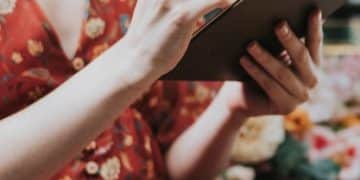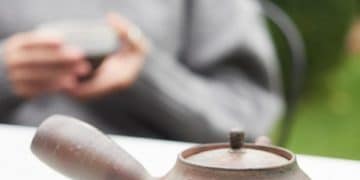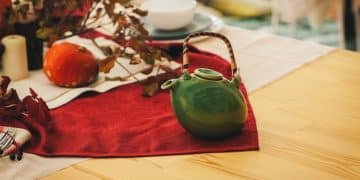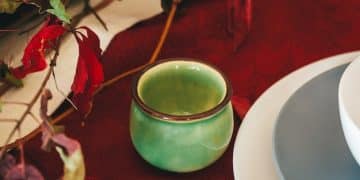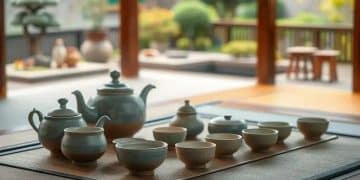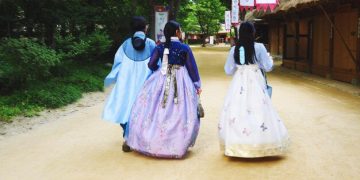Korean Tea Ceremony Etiquette: A Beginner’s Guide for US Participants

Korean Tea Ceremony Etiquette: A Beginner’s Guide for US Participants offers a comprehensive overview of the traditional Korean tea ceremony, focusing on the essential etiquette and customs for US participants to ensure a respectful and enriching experience.
Interested in Korean culture and planning to attend a traditional tea ceremony? Unsure of the proper etiquette? This Korean Tea Ceremony Etiquette: A Beginner’s Guide for US Participants will help you navigate the experience with grace and respect.
Understanding the Korean Tea Ceremony: A Cultural Immersion
The Korean tea ceremony, known as “Darye” (茶禮), is more than just drinking tea; it’s a beautiful and ancient tradition that embodies respect, harmony, and mindfulness. For US participants, understanding its nuances is crucial for a meaningful experience.
History and Significance of Darye
Originating from Buddhist traditions and influenced by Confucian ideals, the Darye holds a significant place in Korean culture. It’s a way to honor ancestors, show respect to guests, and cultivate inner peace.
Key Elements of the Tea Ceremony
The ceremony involves specific rituals, tea preparation methods, and a deep connection between the host, the guests, and the tea itself. Every gesture and movement carries a symbolic meaning.
- Respect: Honoring elders, ancestors, and guests is paramount.
- Harmony: Creating a peaceful and balanced atmosphere enhances the experience.
- Mindfulness: Being present in the moment and appreciating the subtle details of the ceremony.
- Purity: Both the tea and the participants should be clean and pure, both physically and mentally.
Participating in Darye provides a window into the heart of Korean values. For US participants, this offers a deeper cultural understanding.
Essential Etiquette Tips for US Participants
For US participants attending a Korean tea ceremony, knowing the proper etiquette is essential for showing respect and ensuring a harmonious experience. Being mindful of cultural differences is key.
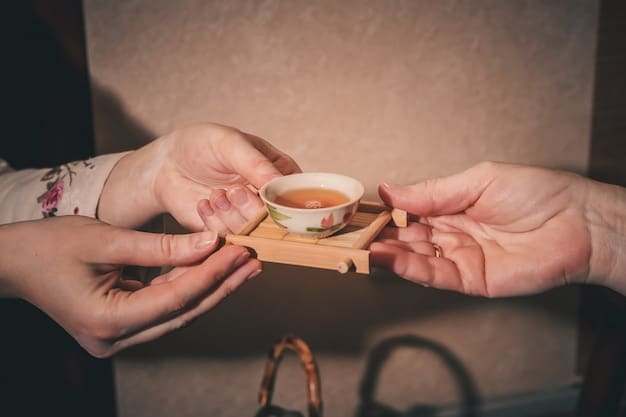
Arriving and Dressing Appropriately
Punctuality is essential. Arrive on time, or even a few minutes early. As for attire, choose modest and respectful clothing. Avoid overly revealing or casual outfits.
Entering the Tea Room
Remove your shoes before entering the tea room. This is a common custom in many Korean homes and traditional spaces. Step inside quietly and respectfully.
By following these basic guidelines, US participants can make a positive impression and show genuine appreciation for the tradition.
Navigating Bowing and Seating Customs
Bowing and seating arrangements are vital aspects of Korean tea ceremony etiquette. Understanding these customs will help US participants demonstrate respect and sensitivity.
Understanding Different Types of Bows
There are varying degrees of bows, each signifying a different level of respect. A slight bow is generally used when greeting or thanking someone, while a deeper bow is reserved for more formal occasions.
Proper Seating Etiquette
Pay attention to seating arrangements, as they often reflect hierarchy and respect. Elders or honored guests are typically seated in the most prominent positions.
- Avoid Crossing Your Legs: This is considered impolite in formal settings.
- Maintain Good Posture: Sit upright and show attentiveness to the ceremony.
- Wait to be Seated: Do not simply sit down without being directed.
By mastering the art of bowing and understanding seating etiquette, US participants can demonstrate their respect and appreciation for the cultural significance of the tea ceremony.
The Art of Receiving and Holding the Tea Cup
The way you receive and hold the tea cup is a crucial element of Korean tea ceremony etiquette. It reflects your respect for the host and the tradition.
Receiving the Tea Cup with Respect
Always receive the tea cup with both hands. This gesture shows that you are accepting the tea with reverence and gratitude.
Holding the Cup Correctly
Hold the cup gently with both hands, avoiding covering the rim with your fingers. This allows you to appreciate the aroma and savor the tea properly.
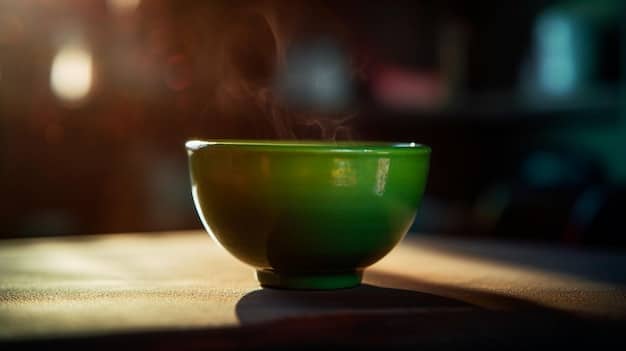
The way you handle the tea cup is a subtle but powerful way to communicate your respect and appreciation for the tradition. US participants should pay close attention to these details.
Engaging in Polite Conversation During the Ceremony
Conversation plays a role in creating a welcoming and harmonious atmosphere during the Korean tea ceremony. However, it’s important to engage in polite and respectful dialogue.
Appropriate Topics of Conversation
Stick to neutral or positive topics, such as the beauty of the tea room, the quality of the tea, or general aspects of Korean culture. Avoid controversial or sensitive subjects.
Listening Attentively and Responding Respectfully
Pay close attention to the speaker and show genuine interest in what they have to say. Respond thoughtfully and respectfully, avoiding interruptions or disagreements.
- Avoid Loud Talking: Keep your voice low and speak calmly to maintain a peaceful atmosphere.
- Show Appreciation: Express your gratitude to the host for their hospitality.
- Be Mindful of Body Language: Maintain eye contact and show positive engagement.
Polite conversation contributes to the overall harmony of the tea ceremony. US participants can enhance the experience by engaging respectfully and thoughtfully.
Understanding the Significance of Teaの種類
Teaの種類 plays a central role in Korean tea culture, influencing the taste, aroma, and overall experience of the tea ceremony. Exploring the diverse world of Korean teas adds depth to the Darye.
Different Types of Korean Tea
From green teas like Sejak and Jungjak to fermented teas like Hwangcha, Korean tea offers a wide range of flavors and aromas. Each type has its unique characteristics and preparation methods.
The Importance of Tea Quality
The quality of the tea is essential to the overall experience of the Darye. High-quality tea is carefully selected and prepared to bring out its best qualities.
Understanding types of tea enhances the Darye experience. For US participants, exploring Korean tea adds cultural richness.
Adapting to Cultural Nuances and Showing Genuine Appreciation
The Korean tea ceremony is steeped in cultural nuances that can be challenging for US participants to fully grasp. Showing genuine appreciation is key for a positive experience.
- Being open to learning and adapting to unfamiliar customs.
- Actively listening to the host and other participants.
- Expressing sincere gratitude for the opportunity to participate.
Showing genuine respect and appreciation ensures a positive experience for both the visitors and the hosts.
| Key Point | Brief Description |
|---|---|
| 🍵 Respectful Arrival | Arrive on time, dress modestly, and remove shoes before entering. |
| 🙇 Proper Bowing | Understand different bow types and use them appropriately. |
| 🤝 Receiving the Cup | Receive the tea cup with both hands as a sign of respect. |
| 🗣️ Polite Conversation | Engage in respectful and neutral conversation topics. |
Frequently Asked Questions(FAQ)
▼
Choose modest and respectful attire. Avoid overly revealing or casual outfits. Traditional Korean clothing, known as Hanbok, is appropriate if you have access to it.
▼
It’s best to ask the host for permission before taking photos. Some ceremonies may not allow photography to maintain the solemnity of the event.
▼
Express your gratitude verbally, using phrases like “Gamsahamnida” (thank you). A slight bow is also a respectful gesture to show appreciation.
▼
It’s polite to at least try the tea. Take a small sip to show respect. You don’t need to finish the entire cup if you truly dislike it.
▼
Avoid controversial or sensitive topics, such as politics or personal matters. Stick to neutral and positive subjects like tea, culture, or the beauty of the surroundings.
Conclusion
By understanding and respecting the etiquette of the Korean tea ceremony, US participants can fully appreciate this beautiful tradition and create memorable cultural experiences. Embracing these customs enriches the ceremony for all involved.
